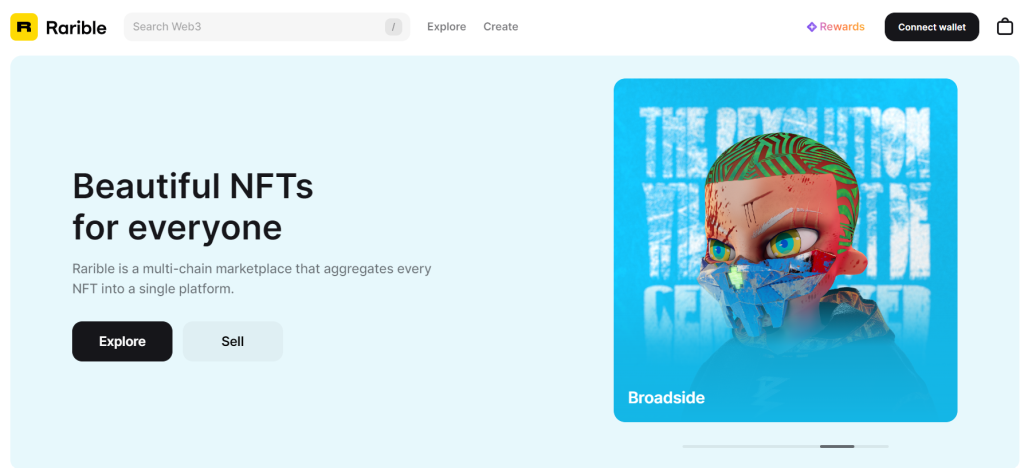Why NFT marketplace is a profitable model
An NFT marketplace is profitable because it earns money from market activity. It basically makes money every time someone trades on it.
Most marketplaces take a small cut from each transaction, usually around 2–5%. That doesn’t sound like much. But when thousands of users are trading NFTs worth millions of dollars, those small percentages add up very quickly.
Once you’ve built the platform, it doesn’t cost much more to handle more users. This means, as you grow, you’re not spending a ton more money, you gain more profit from the transactions.
Plus, you can make money in different ways. Some marketplaces charge extra for featured listings, verification checkmarks, or premium accounts. Others take a percentage every time an NFT gets resold, so the same digital item keeps generating revenue over and over.
There’s also this strong network effect. More artists join because there are lots of buyers, and more buyers show up because there’s tons of art to choose from. Once your marketplace becomes the go-to platform, this strong network effect will help stabilize long-term revenue.
However, this is not a guaranteed goldmine. The NFT market goes through ups and downs, and you need solid security and a good user experience to stand out. But this model always has real potential if you can execute it well.
The next part will dive deeper into the different ways an NFT marketplace can actually make money.
How to monetize an NFT marketplace (How to make money)
An NFT trading platform could only work and function efficiently with a proper NFT business model. Current NFT marketplace revenue comes from a wide range of streams:
Listing fees
NFT Marketplaces is like cybermarket, and content creators are sellers. If they want to display their work, they need to pay some fees for NFT Marketplaces’ owners; this is what we call “listing fees”. And then crypto collectibles developed by creators would be well-categorized based on types, price, demand from investors, and other factors.
Some NFT marketplaces currently don’t charge fees for minting NFTs but charge some fees in case users want to list them for trading. And some allow users to create and list NFTs on their marketplace for free and then charge 2,5% per NFT that sold successfully.
Transaction processing charges
This is one must-have cost users must pay when joining a peer-to-peer transaction. This is also regarded as NFT trading platforms’ primary method to generate revenue. Most marketplaces will only charge the buyer around 2% – 5% per transaction. The transaction charges are to pay for gas fees to maintain the function of the blockchain network.
Setup fees
This is not a fixed cost as NFT marketplaces charge this fee differently, even some do not charge any, LIQNFT, for example. As every NFT platform is backed up with a blockchain protocol, creators need to pay a specific fee to be able to update their collection on the platforms and list it for sale.
Private sale
Private sale is often conducted for exclusive and unique collectibles as it restricts how many investors can access assets and have the right to buy. This process might take some time for NFT sellers, from listing their sales as private, and deciding which wallet addresses are eligible to purchase to finding a potential buyer, so some NFT marketplaces charge a fee for any sellers who organize a private sale.
Bidding charges
Bidding is one of the unique and awesome NFT marketplace features as it creates competition and chances for sellers to earn more money. Hence, the NFT Trading platform often charges some fees for buyers who successfully bid for any collectibles.
Affiliate program
This is an exclusive program for partners of NFT marketplaces. They would get more incentives, such as real-time updates on the demand for collectibles they sell, the ability to host airdrop and bounty programs, and the integration of HTTP API to filter information, for example, bids, digital assets, and wallet addresses.
So which business model should your marketplace choose?
At this point, you may want to know which model actually makes sense for yours. Here’s a practical way to think about it.
If your marketplace is new and has little traffic, avoid relying on transaction or bidding fees. With low trading volume, these fees won’t generate meaningful revenue. In most cases, the focus should be on building liquidity first, not monetization. Charging listing or setup fees at this stage is also difficult unless you offer something clearly differentiated.
If you’re building an open marketplace targeting volume, transaction processing charges and bidding fees are usually the core model. This works only when trading happens frequently. Affiliate programs can help accelerate growth, but they amplify existing activity, they don’t replace liquidity.
If your marketplace is curated or focused on private sales, transaction volume matters less than trust and perceived value. Private sales, higher commissions, or setup fees make sense here, but only when the platform has strong brand credibility and clear quality control.
In practice, most successful marketplaces start with one primary revenue model and add others later. Trying to monetize everything at the beginning often weakens user adoption instead of improving revenue. Instead, you should choose the model that fits how users will actually behave on your platform, not how you want them to behave.
- Explore further: How to create your own NFT Marketplace (7 steps with tutorials)
Examples of successful NFT marketplace business models
There is nothing better than learning NFT Marketplace Business Models from successful cases. Here are 3 monetization strategies from OpenSea, Rarible, and Superare:
OpenSea
OpenSea is one of the biggest NFT Marketplaces worldwide, and transaction fees are the primary source of generating revenues for this platform. Open Sea charges 2.5% per sale to any buyers. This means if you buy an NFT for 10 ETH, Open Sea would make 0.25 ETH.

Some other fees may include account registration fees, which are a one-time fee to allow users to sell on this platform, a one-time contract approval fee, and gas fees. Yet, the gas fees are excluded from revenues.
Rarible
Rarible has two main revenue streams: transaction fees and $RARI exchange cost. Unlike OpenSea, which charges a buyer per sale, Rarible charge 2.5% per transaction on both buyers and sellers. This means if you buy an NFT for 10 ETH on Rarible, they would make 0.5 ETH, double that of Open Sea.

Rarible also earns money thanks to its own token, $RARI. This token is mainly used for governance and paying for those making transactions on Rarible, and this platform could generate revenues from exchanging these tokens.
SuperRare
Similar to Rarible, Superare generates revenues by transaction fees and exchanging its own token – $RARE. Superrare charges 3% per any transactions on buyers. This means if you buy an NFT for 10 ETH on Superrare, they will make 0.3 ETH.

Its token, $RARE was issued to 7.500 early adopters (founders included). Based on the demand of the total market, early adopters could decide to bid, trade and exchange to raise the value of these tokens, and this is how SuperRare earns money.
Final thoughts
There came a time when NFT Market lost its own attractiveness, yet we can’t deny that the cryptocurrency economy is the future! In the years to come, we may see more and more NFT marketplaces launching. It could be NFT platforms that don’t target the majority but choose some niches to get started. Be it customized NFT selling platforms or all-in-one marketplaces, longing for a sustainable NFT Marketplace business model is always a good idea to earn huge profits.
Let us help you realize your big ideas and consult you with the most profitable NFT Marketplace Business Model you could go for!
More related posts from our Blockchain blog you shouldn’t skip:
- The Complete Guide of How To Find The Best NFT Developers (2025 Edition)
- How To Estimate NFT Marketplace Development Cost
- White label NFT marketplace – A full guide for businesses
How useful was this post?
Click on a star to rate it!
Average rating / 5. Vote count:
No votes so far! Be the first to rate this post.




